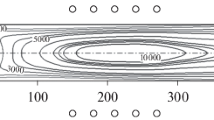Abstract
Heat transfer in the subsonic high-enthalpy air flow in the VGU-4 induction plasmatron is experimentally and numerically investigated for three versions of the sectional discharge channel with the exit section diameters of 30, 40, and 50 mm. The model was a flat-nosed cylinder, 20 mm in diameter. Using a Gamma code the enthalpy he and the velocity at the jet axis are numerically reconstructed from the experimental data. The method for approximately determine the enthalpy he on the basis of the experimental data and the Fay—Riddell formula for the heat flux is proposed. The effective dimensionless model radius reff is introduced, which makes it possible to take account for the dependence of the flow at the outer edge of the boundary layer on the model and discharge channel geometries and the plasmatron operation regime. The value of reff is calculated for the VGU-4 operation regimes with a simple cylindrical discharge channel and a sectional channel. The values of the enthalpy he calculated using the “exact” and approximate methods are compared: the greatest difference in the he values amounts to 6%.
Similar content being viewed by others
References
A. N. Gordeev, A. F. Kolesnikov, and M. I. Yakushin, “An induction plasma application to “Buran’s” heat protection tiles ground tests,” SAMPE J. 28 (3), 29–33, (1992).
A. N. Gordeev and A. F. Kolesnikov, “High-frequency induction plasmatrons of the VGU series,” in: Topical Problems in Mechanics. Physical and Chemical Mechanics of Liquids and Gases (Nauka, Moscow, 2010), p. 151–177 [in Russian].
G. N. Zalogin, B. A. Zemlyanskii, V. B. Knot’ko, I. N. Murzinov, A. N. Rumynskii, and L. A. Kuz’min, “highfrequency plasmatron: a setup for investigating aerophysical problems using high-enthalpy gas flows,” Kosmonavt. Raketostr., No. 2, 22–32 (1994).
B. E. Zhestkov, “Investigation of thermochemical stability of thermal protection materials,” TsAGI Science J. 45 (8), 781–802 (2014).
B. Bottin, O. Chazot, M. Carbonaro, V. Van Der Yaegen, and S. Paris, “The VKI plasmatron characteristics and performance,” in: Measurement Techniques for High Enthalpy and Plasma Flows (NATO-RTO-EN-8, 1999).
G. Herdrich, M. Auweter-Kurtz, H. Kurtz, T. Laux, and M. Winter, “Operational behavior of inductively heated plasma source IPG-3 for entry simulations,” J. Thermophysics Heat Transfer 16 (3), 440–449 (2002).
M. Dougherty, W. Owens, J. Meyer., and D. Fletcher, “Investigations of surface-catalyzed recombination reactions in mars atmosphere,” in: 49th AIAA Aerospace Sciences Meeting Including the New Horizons Forum and Aerospace Exposition, 4–7 January 2011, Orlando, Florida.
A. F. Kolesnikov, “Conditions of simulation of stagnation point hear transfer from a high-enthalpy gas,” Fluid Dynamics 28 (1), 131–137 (1993).
A. F. Kolesnikov, “Local similarity conditions of the thermochemical interaction between high-enthalpy gas flows and an indestructible surface,” High Temperature 52(1), 110–116 (2014).
V. M. Doroshenko, V. M. Mysova, Yu. K. Rulev, and M. I. Yakushev, “Measuring enthalpy in high-temperature subsonic nitrogen and air jets in an induction plasmatron,” Ingh.-Fiz. Zh. 53 (3), 492–493 (2014).
J. A. Fay and F.R. Riddell, “Theory of stagnation point heat transfer in dissociated air,” J. Aeronaut. Sci. 25 (2), 73–121 (1958).
W. H. Dorrance, Viscous Hypersonic Flow (McGraw-Hill, New York, 1962).
S. A. Vasil’evskii and A. F. Kolesnikov, “Numerical simulation of equilibrium induction plasma flows in a cylindrical plasmatron channel,” Fluid Dynamics 35 (5), 769–777 (2000).
S. A. Vasil’evskii and A. F. Kolesnikov, “Numerical investigation of flow and heat transfer in induction plasma of a high-frequency plasmatron,” in: Encyclopedia of Low-Temperature Plasmas. Series B. Vol. VII-1. Part 2 (Yanus-K, Moscow, 2008), pp. 220–234 [in Russian].
S. A. Vasil’evskii and A. F. Kolesnikov, “Numerical investigation of flow and heat transfer in an induction plasmatron and determination of catalytic activity of materials,” in: Topical Problems in Mechanics. Mechanics of Liquids, Gases, and Plasmas (Nauka, Moscow, 2008), pp. 95–123 [in Russian].
N. G. Bykova, S. A. Vasil’evskii, and A. F. Kolesnikov, “The Effect of radiation on the spatial distribution of the temperature of subsonic flows of induction plasma,” High Temperature 42 (1), 12–19 (2004).
S. T. Surzhikov, Thermal Radiation of Gases and Plasmas (Bauman Moscow State Techn. Univ., 2004) [in Russian].
D. Vanden Abeele, S. A. Vasil’evskii, A. F. Kolesnikov, G. Degrez, and V Bottin, “Code-to-code validation of inductive plasma computations,” Ed. by P. Fauchais and J. Amouroux, Progress in Plasma Processing of Materials (Begell House, New York, 1999), pp. 245–250.
S. Patankar, Numerical Heat Transfer and Fluid Flow (Hemisphere Publ. Corp., New York, 1980).
S. A. Vasil’evskii, I. A. Sokolova, and A. V. Andriatis, “Description of the SoVA software package intended for the calculations of the equilibrium composition and transport coefficients of low-temperature plasma in the higher approximations of the chapman—enskog method,” Electronic Journal “Physico-Chemical Kinetics in Gas Dynamics”, 2005, http://chemphys.edu.ru/media/published/2005-06-14-001.pdf
A. F. Kolesnikov and M. I. Yakushin, “Determination of the effective probabilities of heterogeneous atom recombination from heat fluxes to surfaces in a dissociated air flow,” Mat. Model. 1 (3), 44–60 (1989).
I. V. Petukhov, “Numerical Calculations of Two-Dimensional Boundary Layer Flows,” in: Numerical Methods for Solving Differential and Integral Equations and Quadrature Formulas (Nauka, Moscow, 1964), pp. 304–325 [in Russian].
Author information
Authors and Affiliations
Corresponding author
Additional information
Russian Text © The Author(s), 2019, published in Izvestiya RAN. Mekhanika Zhidkosti i Gaza, 2019, No. 3, pp. 98–112.
Rights and permissions
About this article
Cite this article
Vasil’evskii, S.A., Gordeev, A.N. & Kolesnikov, A.F. Heat Transfer and Thermophysics of Subsonic Dissociated-Air Jets in Flow past a Cylindrical Model in a High-Frequency Induction Plasmatron. Fluid Dyn 54, 389–403 (2019). https://doi.org/10.1134/S001546281903011X
Received:
Revised:
Accepted:
Published:
Issue Date:
DOI: https://doi.org/10.1134/S001546281903011X




